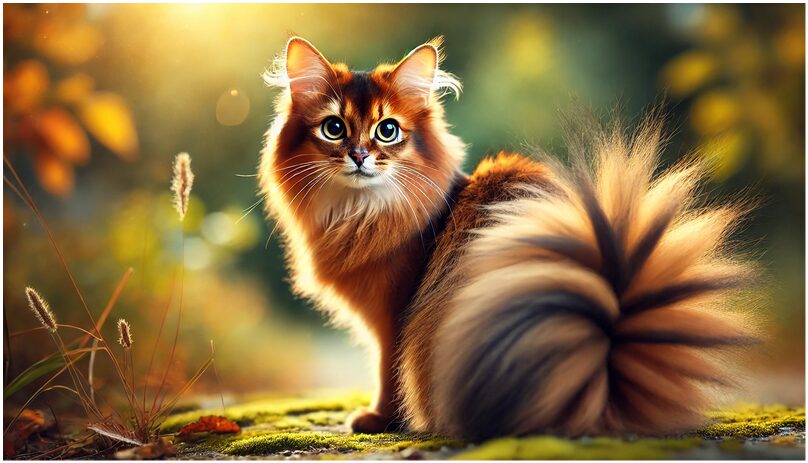The Somali cat is an alluring breed known for its bushy tail, luxurious fur, and playful personality. Often called the “fox cat” due to its striking resemblance to a wild fox, the Somali cat is a breed that captivates the hearts of cat lovers worldwide. Whether you’re interested in their history, care, or suitability for your home, this guide will cover everything you need to know about Somali cats.
Origins and History of the Somali Cat
The Somali cat shares its roots with the Abyssinian, a breed known for its agouti coat and ancient origins. While the Abyssinian has a short, sleek coat, the Somali boasts a semi-longhaired variation that adds to its foxy allure.
The breed’s history began somewhat serendipitously in the 1940s when longhaired kittens occasionally appeared in Abyssinian litters. At first, these kittens were not particularly sought after by breeders. However, by the 1960s, breeders in the U.S., Canada, and Australia began taking an interest in these fluffy Abyssinians and sought to develop them as a distinct breed.
In 1972, the name “Somali” was given to these cats, reflecting their mysterious and exotic appearance. Despite the name, the breed has no direct connection to Somalia. It was officially recognized by the Cat Fanciers’ Association (CFA) in 1979 and later by other international cat registries, solidifying its place as a beloved breed worldwide.
General Characteristics of the Somali Cat
Appearance
The Somali is often described as a “miniature fox,” thanks to its bushy tail, large almond-shaped eyes, and tufted ears. It has a semi-longhaired coat that comes in various warm tones, including:
- Ruddy: The most common color, resembling a burnt orange with ticking of black.
- Sorrel (Red): A cinnamon hue with ticking in a darker copper tone.
- Blue: A cool, soft blue with darker blue ticking.
- Fawn: A warm, muted beige with lighter fawn ticking.
The Somali’s fur has a distinctive “ticked” pattern, meaning each individual hair has bands of color that create a shimmering effect. This agouti coat gives them a wild, yet refined appearance.
Size and Build
Somali cats are medium-sized, with males typically weighing between 8 to 12 pounds and females slightly smaller at 6 to 10 pounds. They are graceful and athletic, with a well-muscled body and a long, bushy tail.
Personality
Somali cats are highly energetic, intelligent, and curious. They love to explore their surroundings and are often found perched in high places to observe their environment. These cats are very playful and can be mischievous, always seeking out new adventures or interactive playtime.
Their playful nature extends into their adult years, so if you adopt a Somali, expect a lifelong kitten at heart. They thrive on companionship and will form strong bonds with their human family members. Somalis are known to be friendly, making them a good choice for families with children or other pets.
However, they are also quite independent and enjoy having time to themselves. If left alone for long periods, they might become bored and act out, so interactive toys and puzzles are great for keeping them mentally stimulated.
Health Issues
Like all breeds, the Somali cat has some genetic predispositions to certain health conditions. However, it’s generally considered a healthy breed with a lifespan of 12 to 16 years when cared for properly. Here are a few common health issues to be aware of:
- Gingivitis: Dental care is essential for Somali cats, as they are prone to gum disease. Regular brushing and dental check-ups are recommended.
- Pyruvate Kinase Deficiency (PKD): This genetic condition can cause anemia. Responsible breeders often test for PKD to avoid passing it on to kittens.
- Progressive Retinal Atrophy (PRA): A degenerative eye disease that can lead to blindness, PRA is something to watch for, especially in aging Somalis.
Routine vet visits, a balanced diet, and maintaining a healthy weight will go a long way in keeping your Somali cat healthy and happy.
Grooming Requirements
The Somali’s semi-longhaired coat requires regular grooming to keep it looking its best. While they don’t have the extensive grooming needs of a Persian, brushing your Somali cat 2 to 3 times a week will help prevent matting and reduce shedding. This regular brushing also helps keep the coat’s natural oils distributed, maintaining its sheen.
Bathing is rarely needed unless your cat gets particularly dirty, but you should trim their nails regularly and check their ears for signs of dirt or infection.
Suitable Households for a Somali Cat
Somali cats make excellent companions for a variety of households, but they particularly thrive in homes where they can get plenty of attention and engagement. Ideal for families, they get along well with children who understand how to interact gently with animals. They also tend to do well with other cats or dogs, especially if introduced gradually.
If you work from home or spend a lot of time at home, a Somali can be the perfect partner in your daily activities. They love being involved and will often follow you from room to room, curiously inspecting whatever you’re doing.
However, if your household is more laid-back or if you’re away from home often, the Somali may not be the best match unless you have plenty of enriching toys and possibly another pet to keep them company.
Somali Cats in U.S. Cat Registries
The Somali cat is recognized by most major cat registries, including:
- Cat Fanciers’ Association (CFA)
- The International Cat Association (TICA)
- American Cat Fanciers Association (ACFA)
Each registry has its own breed standard, but they are relatively similar, emphasizing the Somali’s athletic build, ticking on the coat, and foxy appearance.
Final Thoughts: Is a Somali Cat Right for You?
Somali cats are a great fit for those who want an energetic, playful, and intelligent companion. They will charm you with their antics, keep you entertained with their playful nature, and win your heart with their affectionate and loyal personality. However, they require time, attention, and interactive play to stay happy and healthy, so they’re best suited to active households where they won’t be left alone for long periods.
If you’re looking for a cat that combines the beauty of a wild animal with the loving temperament of a domestic pet, the Somali cat might just be your perfect match!
Helpful Resources for Somali Cat Lovers
By bringing a Somali cat into your home, you’re not just adopting a pet—you’re gaining a lively, playful, and affectionate companion for years to come.







Heya i am here for the first time. I found this really useful.
Hi there! Your blog provided valuable information. You have done a marvellous job!